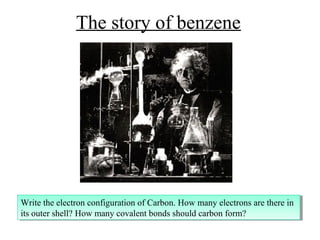
Benzene story
- 1. The story of benzene Write the electron configuration of Carbon. How many electrons are there in Write the electron configuration of Carbon. How many electrons are there in its outer shell? How many covalent bonds should carbon form? its outer shell? How many covalent bonds should carbon form?
- 2. A new hydrocarbon isolated by Michael Faraday in 1825 Carbon = 92% Carbon (Atomic mass = 12) Hydrogen = ? % (Atomic mass = 1) Relative molecular mass = 78. Calculate the empirical formula then the molecular formula C H Molecular formula % 92 100-92 = 8 Known RMM / RMM of % divided by RAM 92 / 12 = 7.67 8/1=8 empirical formula Divide by smallest 7.67 / 7.67 = 1 8 / 7.67 = 1.04 78 / (12 + 1) = 6 Ratio 1 1 The empirical formula is CH and the molecular formula is C 6H66suggesting that the The empirical formula is CH and the molecular formula is C 6H suggesting that the molecule contained aalarge number of double bonds. molecule contained large number of double bonds.
- 3. 2 minute challenge: Draw as many possible structures for a hydrocarbon with the formula C6H6 Make sure the structures satisfy the requirements of 4 bonds per carbon and 1 bond per hydrogen! In 1865 after a dream about a snake biting its own tale, Kekulé suggested the following structure for benzene. Does this structure meet all the requirements of benzene?
- 4. Problem 1: Lack of reactivity of benzene Chemists at the time were convinced that benzene (like other alkenes) should react with bromine in the dark at room temperature. Bromine water (brown) + alkene → Bromoalkane solution (colourless) Observation: This did NOT happen with benzene. Conclusion: Benzene is not a normal alkene
- 5. Problem 2: Thermodynamic stability of benzene Enthalpy of hydrogenation (addition of hydrogen) to cyclohexene was found to be -119kJmol-1 Predict the enthalpy of hydrogenation of benzene Predict the enthalpy of hydrogenation of benzene
- 6. Theory verses experiment Since three double bonds are present in benzene, then the comparable reaction should liberate 3 times the energy of cyclohexene = -(3 × 119) = - 357 kJ mol-1 Experimentally determined value for the hydrogenation of benzene ΔH (hydrogenation) = -208kJ mol-1 Is Benzene more or less stable than expected? Benzene is (360-208) = 149 kJ mol-1 more stable than otherwise expected, or if it contained 3 ordinary C=C bonds.
- 7. E Benzene (predicted value) Difference = 149kJ/mol -357kJ/mol (3 Benzene (actual value) X –120) Structure ??? Cyclohexane -208kJ/mol progress
- 8. Problem 3: Bond lengths of benzene Bond Lengths /nm C-C cyclohexane 0.154 C=C cyclohexane 0.134 •Compare the length of a single bond to a double bond •Draw what benzene would look like if the different length double and single bonds are alternating to form a 6 member ring. Clue: Its not a perfect hexagon
- 9. What benzene would look like if it had fixed alternating double-single bonds… Different bond lengths in benzene would cause distortion Q. Who is this celebrity? A. Simon Cowell
- 10. Direct evidence 1981 an atomic surface probing technique was developed called Scanning Tunneling Microscopy (STM). The first published STM image showed benzene with an undistorted hexagonal shape. www.newton.ex.ac.uk
- 11. All the bonds in benzene have the same length... Bond Lengths /nm C-C cyclohexane 0.154 C=C cyclohexane 0.134 C-C in benzene 0.140 •How does the carbon-carbon bond length of benzene compare to double and single carbon-carbon bonds? 1. All bonds are of equal length 2. The bond length is between a double bond and a single bond. • What do these two facts suggest about the structure of benzene?
- 12. The double-single bonds can’t be fixed in position! Resonance suggests the two structures rapidly alternate between the two forms. The resonance explanation suggests that Benzene is in such rapid equilibrium between the two forms; we detect a ‘blurred’ combination of the two forms. The electrons from the double bonds are therefore drawn as a circle shared equally between the carbon atoms.
- 13. Current theory: •Some text books still use the word “resonance” to describe the structure of benzene. •There is NO evidence to support two rapidly changing forms of benzene. •Modern organic chemists use the word “conjugation” to describe how the electrons are delocalized (spread) across the whole molecule… Valence bond theory explains the bonding in benzene as a series of unhybridized p-orbitals which overlap forming a cloud of electron density above and below the molecule. The spreading of electrons STABILIZES the molecule.
- 14. Drawing benzene Which drawing most accurately represents the structure and bonding in Benzene? Explain Are any of the pictures completely incorrect? (i.e. not Benzene) if so which and why? Which representation takes longest to draw? Which is quickest to draw? In your opinion which picture is best overall? Why? •D is incorrect (cyclohexane not benzene!) •A doesn’t show delocalized electrons and is time consuming to draw •Organic chemists tend to use B or C if they want to draw mechanisms
- 15. Questions 1.Describe the 3 problems that scientists faced when trying to explain the structure and bonding in Benzene. 2.What is the current understanding of the structure and bonding of Benzene? (answer as if you were talking to a chemist who had never heard of Benzene) 3.How does this current knowledge Q2 better explain the problems you mentioned in Q1? 4.“We now fully understand benzene” Do you agree or disagree with this claim? Explain your answer. 5.What is the role of theory and experimentation in the advance of scientific knowledge? Use the story of benzene to support your answer.